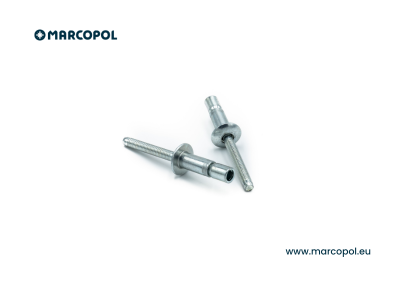
Understanding rivets. A Comprehensive guide by Marcopol
At Marcopol, we specialize in the manufacturing of rivets, which are essential metal fasteners used in various industries for assembling flat parts securely. Understanding the evolution and types of rivets is crucial for choosing the right rivet for your project.
The evolution of rivets
Traditionally, rivets were crafted as solid pieces requiring a bucking or hammering process to secure joints. However, modern engineering has embraced the use of pop or breakstem rivets, which offer a more efficient installation process. These rivets consist of a tubular body with a mandrel through the center. When applied, the mandrel is pulled and eventually snaps off, leaving a tight, secure fixture. This evolution not only simplifies the installation but also enhances the durability and strength of the joint.
Material matters in rivet selection
Choosing the right material for rivets is paramount, as it directly affects the durability and corrosion resistance of the connection. The material should match or closely resemble the mechanical and physical properties of the parts being joined to prevent galvanic corrosion. Here’s a breakdown of materials used in Marcopol rivets:
- Aluminum: Widely used for its versatility and available in various alloy compositions to suit different mechanical requirements. Soft aluminum is ideal for delicate materials, while hard aluminum offers higher tensile and shear resistance.
- Steel: Known for its universal applications due to its strength and durability.
- Stainless Steel: Perfect for outdoor constructions due to its excellent corrosion resistance. It is also preferred in the food industry for its cleanliness and durability.
- Copper: Offers good thermal and electrical conductivity, making it suitable for electrical applications.
- Copper-Nickel Alloy: Ideal for environments prone to corrosion and high temperatures due to its superior resilience.
Choosing the right rivet design
The design of the rivet is another crucial factor. The shape of the rivet head and the section of the shank play significant roles in the functionality and aesthetics of the rivet:
- Head Shape: Common head shapes include dome, flat, mushroom, trapezoidal, and lens-shaped. Dome heads are economical and provide a durable connection, while flat heads allow for a flush finish on the surface.
- Shank Section: Rivets can have solid, hollow, or semi-tubular shanks. Hollow and semi-tubular rivets are not recommended for very hard materials as their structural integrity is less robust than solid rivets.
- Blind Rivets: These are particularly useful when access to the joint is only possible from one side. They are closed on one end and are perfect for tight or hard-to-reach places.
Marcopol’s commitment to quality and innovation
At Marcopol, we are committed to innovating in the field of fastening technologies. Our rivets are designed with precision to meet the highest standards of quality and functionality. By continually advancing our technology and understanding of materials, we ensure that our rivets provide reliable, long-lasting solutions for any joining needs.
Whether you are working on a simple DIY project or a complex industrial application, choosing the right rivet is crucial. With Marcopol’s expertise, you can be confident in the integrity and performance of your assemblies. Explore our range and discover the perfect rivet for your needs today.